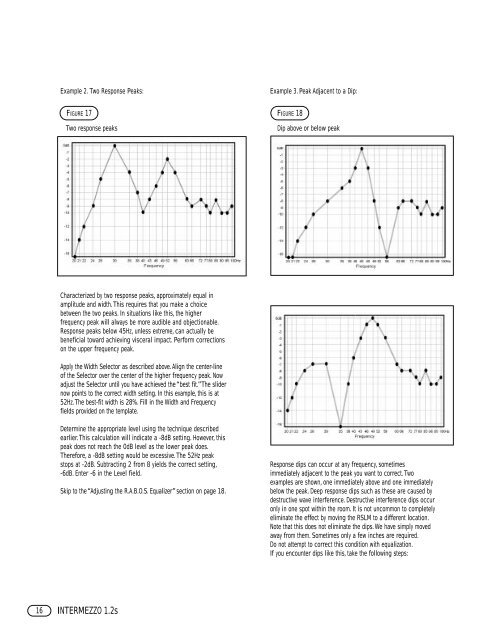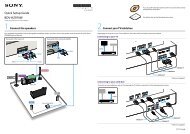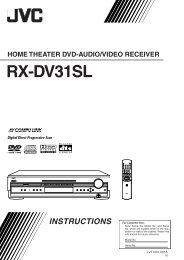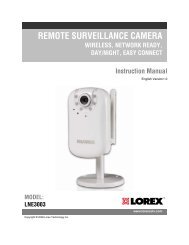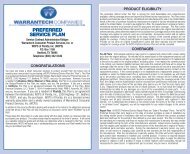Intermezzo 1.2s OM
Intermezzo 1.2s OM
Intermezzo 1.2s OM
Create successful ePaper yourself
Turn your PDF publications into a flip-book with our unique Google optimized e-Paper software.
Example 2. Two Response Peaks:<br />
FIGURE 17<br />
Two response peaks<br />
Characterized by two response peaks, approximately equal in<br />
amplitude and width.This requires that you make a choice<br />
between the two peaks. In situations like this, the higher<br />
frequency peak will always be more audible and objectionable.<br />
Response peaks below 45Hz, unless extreme, can actually be<br />
beneficial toward achieving visceral impact. Perform corrections<br />
on the upper frequency peak.<br />
Apply the Width Selector as described above.Align the center-line<br />
of the Selector over the center of the higher frequency peak. Now<br />
adjust the Selector until you have achieved the “best fit.”The slider<br />
now points to the correct width setting. In this example, this is at<br />
52Hz.The best-fit width is 28%. Fill in the Width and Frequency<br />
fields provided on the template.<br />
Determine the appropriate level using the technique described<br />
earlier.This calculation will indicate a -8dB setting. However, this<br />
peak does not reach the 0dB level as the lower peak does.<br />
Therefore, a -8dB setting would be excessive.The 52Hz peak<br />
stops at -2dB. Subtracting 2 from 8 yields the correct setting,<br />
-6dB. Enter -6 in the Level field.<br />
Skip to the “Adjusting the R.A.B.O.S. Equalizer”section on page 18.<br />
16 INTERMEZZO <strong>1.2s</strong><br />
Example 3. Peak Adjacent to a Dip:<br />
FIGURE 18<br />
Dip above or below peak<br />
Response dips can occur at any frequency, sometimes<br />
immediately adjacent to the peak you want to correct.Two<br />
examples are shown, one immediately above and one immediately<br />
below the peak. Deep response dips such as these are caused by<br />
destructive wave interference. Destructive interference dips occur<br />
only in one spot within the room. It is not uncommon to completely<br />
eliminate the effect by moving the RSLM to a different location.<br />
Note that this does not eliminate the dips. We have simply moved<br />
away from them. Sometimes only a few inches are required.<br />
Do not attempt to correct this condition with equalization.<br />
If you encounter dips like this, take the following steps:


